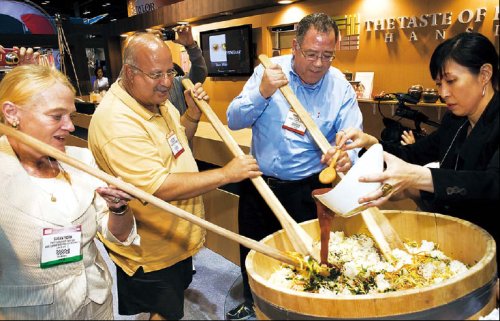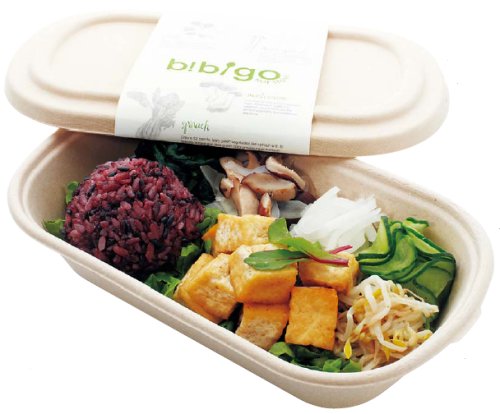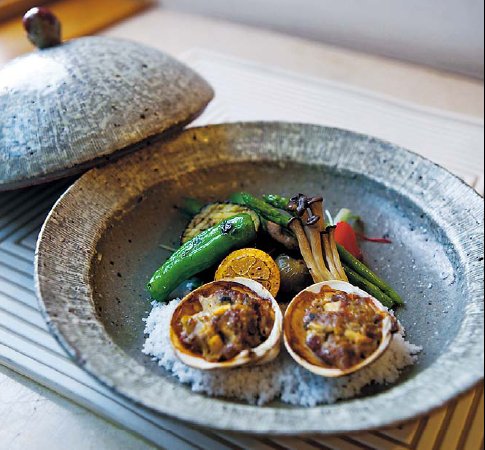This is the last installment of a series that delves into the current movement toward the globalization of Korean cuisine from a variety of perspectives. The series explores hansik’s past and present, its global potential, and efforts that are being made to promote it to the world. - Ed.
Breaking down the government’s efforts to put Korean food in the spotlight
When the government went public with its strategies to globalize Korean cuisine in April 2009, the press had a field day.
Article after article fleshed out the juicy details, describing plans to bump up the number of overseas Korean restaurants from 2007’s 10,000 to 40,000 by 2017, to have up to 100 top-tier hansik restaurants throughout the world by 2017 and to more than double agricultural and seafood exports from $4.4 billion in 2008 to $10 billion by 2012.
The overall mission of the government’s Korean Cuisine to the World project received most of the limelight; getting noticed for its ambitious call to earn hansik a slot amongst the top five cuisines of the world; where it could rub shoulders with gastronomic pop icons like sushi and pasta.
With such massive goals on its plate, the attention -- both positive and critical -- was a given. People wanted to know how the government would accomplish this gargantuan feat.
Now, over a year later, the initial buzz seems to have subsided. During that time, the preliminary goal of getting hansik into the top five was replaced with the broader mission of making hansik an internationally beloved cuisine, says Ministry for Food, Agriculture, Forestry and Fisheries Korean Food Promotion Team deputy director Lee Jeong-sam.
A good two to seven years remain till the project needs to start meeting deadlines. In other words, the campaign has a long way to go, and quite frankly, it is too early to expect concrete results.
Nevertheless, it merits a recap.
Here’s a look at what has been accomplished, what’s still on the to-do list and where improvement might be needed.
The builders
Based on data provided by Lee Jeong-sam, the campaign began to gain solid foundations in March 2008, with the launch of the Korean Food Globalization Forum, a sort-of think tank where strategies could be researched. Following a preliminary announcement of the campaign in October 2008, more exact plans were revealed in April 2009.
In May 2009, two bodies -- the Korean Cuisine Promotion Committee and the Ministry for Food, Agriculture, Forestry and Fisheries’ Korean Food Promotion Team -- were established to plan, manage and oversee the project.
Breaking down the government’s efforts to put Korean food in the spotlight
When the government went public with its strategies to globalize Korean cuisine in April 2009, the press had a field day.
Article after article fleshed out the juicy details, describing plans to bump up the number of overseas Korean restaurants from 2007’s 10,000 to 40,000 by 2017, to have up to 100 top-tier hansik restaurants throughout the world by 2017 and to more than double agricultural and seafood exports from $4.4 billion in 2008 to $10 billion by 2012.
The overall mission of the government’s Korean Cuisine to the World project received most of the limelight; getting noticed for its ambitious call to earn hansik a slot amongst the top five cuisines of the world; where it could rub shoulders with gastronomic pop icons like sushi and pasta.
With such massive goals on its plate, the attention -- both positive and critical -- was a given. People wanted to know how the government would accomplish this gargantuan feat.
Now, over a year later, the initial buzz seems to have subsided. During that time, the preliminary goal of getting hansik into the top five was replaced with the broader mission of making hansik an internationally beloved cuisine, says Ministry for Food, Agriculture, Forestry and Fisheries Korean Food Promotion Team deputy director Lee Jeong-sam.
A good two to seven years remain till the project needs to start meeting deadlines. In other words, the campaign has a long way to go, and quite frankly, it is too early to expect concrete results.
Nevertheless, it merits a recap.
Here’s a look at what has been accomplished, what’s still on the to-do list and where improvement might be needed.
The builders
Based on data provided by Lee Jeong-sam, the campaign began to gain solid foundations in March 2008, with the launch of the Korean Food Globalization Forum, a sort-of think tank where strategies could be researched. Following a preliminary announcement of the campaign in October 2008, more exact plans were revealed in April 2009.
In May 2009, two bodies -- the Korean Cuisine Promotion Committee and the Ministry for Food, Agriculture, Forestry and Fisheries’ Korean Food Promotion Team -- were established to plan, manage and oversee the project.

The Korea Agro-Fisheries Trade Corporation Korean Food Globalization Department Promotion Team is also involved in the campaign. According to department promotion team leader Kim Dong-mook, the corporation had been conducting research on ways to globalize hansik since as early as 2007.
In March 2010, a private organization called the Korean Food Foundation was launched to further help carry out the campaign’s agenda.
According to deputy director Lee, these organizations and teams have been working collectively toward carrying out four overarching master plans.
The four major plans are to construct the framework and conduct the research needed for the campaign, to foster and train hansik chefs and cooks, to strengthen the competitiveness of Korean restaurants, and to do some major hansik PR.
Under these plans, so far, there are around 30 projects, says Lee.
Laying the groundwork
The key to any enterprise lies in sturdy foundations.
According to Lee Jeong-sam, the campaign proposes to build theirs by standardizing Korean food, proving its excellence, figuring out how to commercialize it and by laying down the groundwork for its industrialization.
To that end several projects have been initiated, some of which have reached completion.
In July 2009, gochujang (red pepper paste), doenjang (soybean paste) and ginseng were registered under Codex Alimentarius, putting them on an international list of food-related standards and guidelines, which, says Lee, garners them global recognition.
Lee explained another standardization-related project. An English-language menu and recipe manual was produced last year and distributed to overseas Korean restaurants in America, China and Japan. The purpose of this was to help bring order to the myriad ways of spelling Korean dishes. According to Lee, there are plans to further distribute these manuals.
Aside from projects like the ones above, the campaign has also set out to prove the health benefits of hansik, namely through clinical studies.
For example, Lee revealed that Inje University Paik Hospital and the University of Sydney teamed up to assess the dietary effects of hansik.
According to deputy director Lee Jeong-sam, studies on test subjects -- subjects needed to be average foreigners -- was conducted in Australia from April 2009 to June 2010. One team ate Western food. The other subsisted on Korean food. If results reveal that a hansik diet is more conducive to weight loss then they will be used to help promote Korean cuisine.
Korean Food Foundation secretary-general Lee Yong-soo revealed plans for another clinical study whose aim is to produce scientific data that highlights the healthy appeal of hansik.
“I think it is very important to produce scientific data,” secretary-general Lee asserted.
Lee went on to discuss how they would focus on seeing whether or not patients suffering from high blood pressure, diabetes or other “adult” diseases improved after eating hansik for a fixed amount of time.
“If scientific data are produced in regards to that and if that research material is introduced in an academic journal, particularly a foreign one,” Lee continued. “(Then) won’t it play a role in scientifically proving that hansik is healthy?”
In addition to such studies, the foundation is looking into developing bibimbap sauces and conducting research on the healthy nature of the dish. The sauces, says Lee, are being developed to suit the taste preferences of various countries.
The project seems to bear certain similarities to CJ’s newly-minted bibimbap chain BIBIGO. CJ Foodville’s restaurant enterprise, which will be opening throughout the world, revamped the traditional dish, giving it a set of new sauces and a variety of forms.

While Lee acknowledged that both enterprises might be heading in the same direction, he asserted that there will be differences between theirs and CJ’s.
Fostering hansik talent
If the projects mentioned above seek to serve as a springboard for the globalization of hansik, then the following projects aim to foster and educate the human resources needed to make it happen.
Based on data provided by the Korea Agro-Fisheries Trade Corporation Food Globalization Department Promotion Team, from September to December 2009, a total of 670 cooks, managers, proprietors and employees from overseas hansik restaurants situated in Japan, China, America and France received training in those respective countries.
Surveys assessing overall satisfaction with and understanding of the classes were taken. Results tallied up to an average 4.3 out of a scale of 5.

While training overseas hansik restaurant cooks may prove helpful to the campaign, raising the awareness and knowledge of Korean cuisine amongst chefs-to-be may prove even more effective in globalizing hansik.
After all, initiating culinary students into the world of hansik allows them to add it to their repertoire, thereby increasing the chance that it might show up, in some form or other, on the tables of restaurants that they work at once they have graduated.
To that end, the Ministry for Food, Agriculture, Forestry and Fisheries pushed for setting up Korean cuisine classes at famous culinary schools and academies abroad.
An outcome of that endeavor was the introduction of hansik classes to the well-known Hattori Nutrition College in Japan as of May. Classes focus on teaching students the culture and history of Korean cuisine and the art of Korean cooking techniques. A total of 25 classes are slated to run through December. According to Lee Jeong-sam, hansik classes will continue to be held regularly after December. He also said the Korean Food Foundation was looking into ways to establish an international hansik academy.
Beefing up restaurants
One of the roles of the campaign, according to Lee, is to globalize hansik by expanding funding to expedite the entry of hansik restaurant franchises into the international market.
Financing is not the only challenge a restaurant faces when going overseas. There is the matter of knowing how the industry works in the target country and of knowing what the food culture of that country is like.
According to Korea Agro-Fisheries Trade Corporation Food Globalization Department Promotion Team leader Kim Dong-mook, a series of guidebooks have been written, some yet to be distributed, that lay out strategies for taking the hansik restaurant business abroad to America, Japan, China and Vietnam.
To accomplish this, the help of a global consulting company was enlisted and the guidebooks were distributed to overseas Korean restaurants.
Promoting hansik
Of course, PR cannot be neglected. The promotion of hansik through mass media and other channels to mainstream international audiences and tastemakers in the global culinary arena is crucial to gaining a major foothold abroad.
The upcoming PBS series “Stop and Bap Korea” (working title), for example, holds a great deal of promise. According to Korean Food Promotion Team’s Lee, the 13-episode series is a joint effort between Frappe Productions, the Visit Korea Committee and the Korean Food Foundation, with funding from the Ministry for Food, Agriculture, Forestry and Fisheries and the Ministry of Culture, Sports and Tourism. The Korean food documentary -- which features Michelin three-star chef Jean-Georges Vongerichten -- is slated to be aired by the American non-profit broadcasting service in January.
According to Lee, a series of events held in Korea and overseas promoted hansik, including the widely publicized New York event attended by First Lady Kim Yoon-ok in September 2009.
Room for improvement
Rarely is any massive campaign picture perfect. Where then, might there be room for improvement with the government’s Korean Cuisine to the World project?
“Due to issues like budget allocation, there are so many departments involved that it feels unsystematic and somewhat lax,” traditional Korean pottery manufacturer KwangJuYo CEO Cho Tae-kwon -- a pioneer in the globalization of hansik -- said via e-mail. To that end, Cho suggested that the group of departments be consolidated and operated together.

Kim Jung-ho, management research institute vice president of processed food goliath CJ Cheiljedang -- a corporation known for its efforts toward the globalization of Korean cuisine through endeavors like the development of a U.S. market-friendly gochujang -- also voiced somewhat similar concerns.
He gave his opinion on why companies are not making adequate use of the plans that are being instituted.
“While it is also due to there only being a small number of companies attempting globalization, the actual support of the government is too small to be of real help. I believe that this is because, although lots of plans are being tried out, they are not comprehensive and they each move in a fragmentary manner,” Kim said.
“If each plan that is being pushed forward is tied together to systematically and comprehensively provide support, then I think it can become a strong aid policy.”
The press has also been vocal in its criticism of the campaign, pointing out potential loopholes and flaws.
Chung Woon-chun, Korean Food Foundation chairman and former minister of the Ministry for Food, Agriculture, Forestry and Fisheries, responded to the negative press, saying that because they were still in their early stages that “of course there might be certain aspects that are not up to par.”
“This is not something that will put out results right away,” he explained. “These are issues that need to be resolved calmly and in an orderly fashion while looking 10 or 20 or 30 years ahead.”
By Jean Oh (oh_jean@heraldcorp.com)


















![[Today’s K-pop] Treasure to publish magazine for debut anniversary](http://res.heraldm.com/phpwas/restmb_idxmake.php?idx=642&simg=/content/image/2024/07/26/20240726050551_0.jpg&u=)